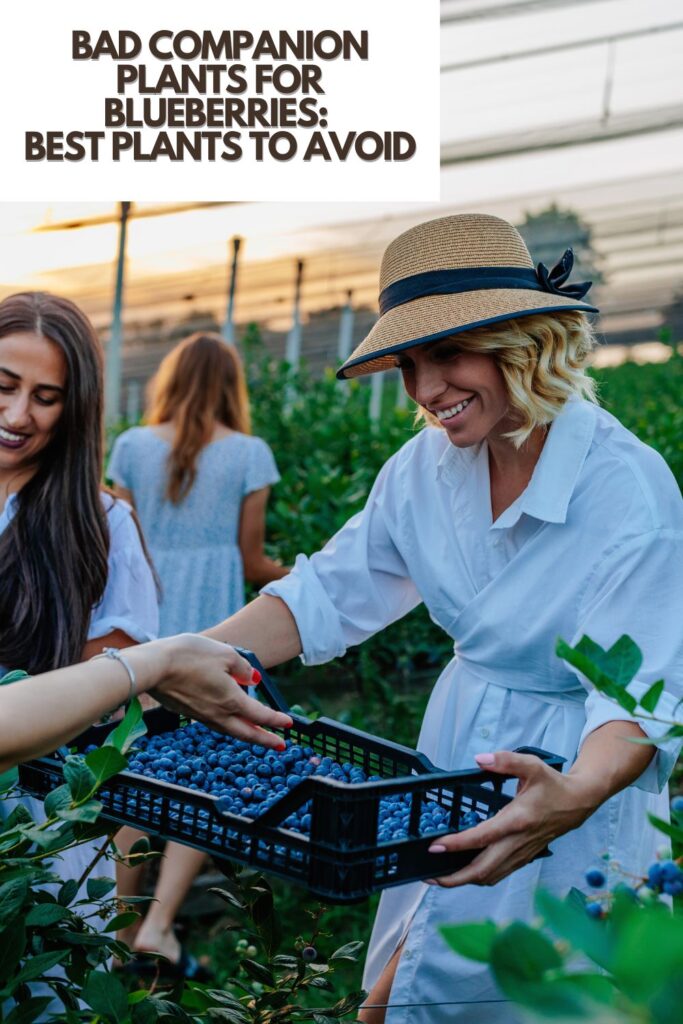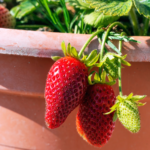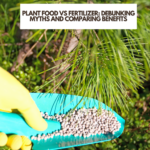What are some bad companion plants for blueberries? When it comes to cultivating blueberries, gardeners often consider companion planting as a strategy to optimize growing conditions and enhance their harvest.
FTC DISCLOSURE: Some of the links in this post are affiliate links. If you click on them and make a purchase, I will receive a small finder’s fee on the sale. This does not increase your price in any way shape or form. Using these links help support the continuation of this website. All opinions are my own. Thank you in advance.
Companion planting involves growing different plants close to one another, providing mutual benefits such as pest control, nutrient supplementation, and more. However, not all plants are suitable companions for blueberries, and it can be crucial to understand which plants can adversely impact the health and yield of your blueberry bushes.
Blueberries thrive in acidic soil, with pH levels ranging from 4.0 to 5.5, which should be taken into account when selecting companion plants. Moreover, it is necessary to identify plants that have similar growing requirements and will not compete with the blueberries for essential resources like water, sun, and nutrients. In the following paragraphs, we will discuss the key factors that contribute to the success of a blueberry garden, including both beneficial and detrimental companion plants to consider in your landscape design.
Key Takeaways
- Soil acidity is crucial for the success of blueberries, and companion plants should thrive in similar pH levels.
- Companion plants should share similar growing requirements and not compete negatively with blueberries for resources.
- Recognizing both beneficial and detrimental companion plants can optimize blueberry yield and enhance garden health.
You Might Also Like To Read:
Using Vinegar For Blueberry Soil
Understanding Companion Planting
What Is Companion Planting
Companion planting is a method used in gardening and agriculture where different plants are grown close together, creating a mutually beneficial relationship. The practice aims to improve soil health, nutrient uptake, and overall plant health through natural processes.
There are many benefits associated with companion planting, including pest control, improved pollination, and reduced need for chemical fertilizers and pesticides. By pairing plants that can help each other thrive, gardeners and farmers can create more resilient and sustainable growing systems.
Pest Control: Some plants can repel or attract insects that are harmful to other plants. For example, certain flowers release chemicals that deter pests, while others attract beneficial insects, such as ladybugs, that prey on garden pests like aphids.
Improved Pollination: Planting flowers alongside crops can attract pollinators like bees, butterflies, and birds, which can help increase the yield of crops that require pollination to produce fruits or seeds.
Enhanced Soil Health: Some plants, such as legumes, have the ability to fix nitrogen in the soil, making it available for other plants to absorb. This process improves soil composition and reduces the need for synthetic fertilizers.
However, it is essential to consider that not all plants make good companions. Certain plants may inhibit the growth of others or attract pests. In the case of blueberries, identifying the plants that may negatively impact their growth is crucial for a successful garden or farm.
You Might Also Like To Read:
Inexpensive Gifts For Plant Lovers
The Basics of Blueberry Cultivation
Growing Requirements of Blueberries
Blueberries thrive in slightly acidic soil with a soil pH around 4.5 to 5.5. They require moist soil but not overly wet conditions. Amending the soil with organic matter such as peat moss or compost helps maintain moisture and acidity. Adequate irrigation is crucial for blueberry growth, especially during the hot summer months. However, care should be taken not to overwater, as overly saturated soil can lead to root rot.
Ideal Soil Conditions for Blueberries
To create ideal soil conditions for blueberries, start with a well-draining mix that retains moisture but does not become soggy. For this, you can use:
- Peat moss
- Composted bark
- Composted leaves
- A mixture of sand, clay, and organic matter
Remember that blueberries prefer an acidic soil, so check the pH regularly and amend with sulfur or another soil acidifier as needed.
Sunlight Requirements for Blueberries
Blueberries grow best in full sun, meaning they require at least 6 to 8 hours of direct sunlight per day. Exposure to ample sunlight promotes healthy growth, better fruit production, and vibrant foliage. If blueberries are planted in areas with insufficient sunlight, they may yield fewer fruits and display sparse foliage. Therefore, it is essential to select an appropriate location in your garden or yard that fulfills their sunlight requirements.
Not so great companion plants for Blueberries
While there’s so many sites telling you the best companion plants for your blueberry shrubs, here are some of the bad companions for blueberry plants. It is a good idea to avoid these:
Planting Strawberries Next To Blueberries
While some flowers can be beneficial to blueberries, others can hinder their growth. Planting strawberry plants next to blueberries will compete for nutrients or water can negatively affect blueberries.
For instance, strawberries may seem like a good ground cover, but they compete with blueberries for the same nutrients and water, ultimately harming both plants. The beautiful flowers that turn into actual strawberries are easy to add to your home garden, but not next to your blueberries.
Planting Raspberries Next To Blueberries
Although blueberries can coexist with certain fruit plants, some fruit varieties may negatively affect blueberry growth. Raspberries, for example, can transmit diseases to blueberries, such as the raspberry mosaic virus. Planting these two close to each other can lead to transmission and affect the overall health of the blueberry bush.
Planting Beets Next To Blueberries
While a vegetable garden can complement blueberry bushes, some vegetables must be avoided. Beets are known to consume a vast amount of nutrients from the soil, ultimately competing with blueberry plants and decreasing their growth potential.
Planting Asparagus Next To Blueberries
Another vegetable to avoid planting alongside blueberries is asparagus. They tend to alter the soil pH, which will not meet the acidic condition that blueberries require for optimal growth.
Planting Thyme Next To Blueberries
Many herbs can stimulate blueberry growth, but some can be detrimental. Thyme, for example, are less than ideal companion plants for blueberries. They compete for nutrients and serve as an aggressive ground cover that may engulf the blueberry plant.
Planting Basil Next To Blueberries
Similarly, basil may seem like a suitable companion plant, but it requires a higher pH level, which is not ideal for blueberries. Choosing the right herbs to accompany blueberries is essential to achieve the desired outcome.
Detrimental Companion Plants for Blueberries
Tomatoes and Blueberries: A Bad Pairing
Tomato plants and blueberries are not good companion plants. Blueberries require acidic soil with a pH level between 4.5 and 5.5, while tomatoes prefer a more neutral to slightly acidic soil, with a pH level between 6.0 and 6.5. Planting these two together may lead to suboptimal growth for both plants.
Furthermore, tomatoes are part of the nightshade family, which also includes eggplants, peppers, and potatoes. Many nightshade plants are known to attract pests that can damage blueberries, such as aphids and whiteflies.
Blueberries and Brassicas: A Poor Combination
Similarly, blueberries should not be planted near brassicas, such as cabbage, kale, cauliflower, and brussel sprouts. Brassicas are heavy feeders and compete with blueberries for soil nutrients. In addition, brassicas release chemicals during decomposition that could affect the growth of blueberries.
Planting Beans Next To Blueberries
It is also advisable to avoid planting blueberries near beans and melons. Beans can attract Japanese beetles, which may also feed on blueberry plants, while melons are prone to various fungal diseases that could potentially spread to the blueberry bushes. Plus, pole beans can end up growing and vining over the blueberry bushes.
Influence of Companion Plants on Blueberries
Impact on Pest Control
Blueberries are susceptible to various pests, including aphids, cabbage worms, and other harmful insects. Choosing the right companion plants can have a significant influence on managing these pests. Some plants, such as borage, deter pests from invading the blueberry bushes by releasing potent scents or chemicals that repel or confuse them.
Additionally, companion plants can also attract beneficial insects, like ladybugs. These predators can help keep pest populations under control, reducing the need for harmful chemical pesticides. A well-planned companion planting strategy can lead to a healthier and more productive blueberry crop.
Impact on Pollination
Pollination is crucial for blueberry fruit production. Companion plants can play an essential role in attracting and supporting pollinators, such as bees, butterflies, and other insects. By providing habitat and nectar sources for these pollinators, companion plants improve blueberry pollination and increase yield.
To maximize the effect of companion plants on pollination, consider planting flowering species nearby to provide a continuous supply of nectar. By doing so, you can create a thriving ecosystem that attracts beneficial insects and supports the growth and productivity of your blueberry bushes. The flower buds of beneficial companion plants can make pollination much easier.
Additional Considerations for Blueberry Companion Planting
Importance of Spacing
Proper spacing is essential for the healthy growth of blueberries and their companion plants. Adequate space allows for air circulation, reducing the chances of pests and diseases. It also ensures that the plants have sufficient access to sunlight, moisture, and nutrients from the soil.
Gardeners should avoid overcrowding, as it can lead to competition for resources and negatively affect overall plant health. When planting in raised beds, it’s recommended to space blueberry bushes approximately 4-5 feet apart for adequate growth. Companion plants should be spaced according to their specific requirements as well.
Appropriate Mulching Techniques
Mulching is a crucial aspect of blueberry companion planting. The right mulch helps in moisture retention, reduces weed growth, and contributes to the organic matter in the soil. Natural mulches, such as pine bark, pine needles, or wood chips, are highly suitable for blueberries as they maintain soil acidity and promote healthy growth.
To ensure effective moisture retention, apply a 2-3 inch layer of mulch around the base of the plants. It is essential to keep the mulch from directly touching plant stems, as it may cause rot or fungal issues. Gardeners should also monitor and replenish the mulch regularly to maintain a consistent layer.
Conclusion
Blueberries are a popular and nutritious fruit, but their cultivation can be tricky with consideration to companion plants. It is essential to understand the negative interactions that can occur with some plants when placed near blueberries.
Blueberries thrive in acidic soil, and therefore, it is important to avoid planting them alongside plants with alkaline soil requirements, such as asparagus and basil. These plants can negatively impact blueberry growth and yield.
In addition, certain plants can attract pests that can harm blueberries, such as tomatoes and peppers. These plants are prone to attracting insects like aphids and spider mites, which can easily migrate to the blueberry plants and cause damage.
Furthermore, the water requirements of blueberries can cause complications when planted near species with high or low water needs. Willows and poplars, for example, can consume large amounts of water, leaving blueberries with insufficient resources for optimal growth.
In conclusion, planning a garden around blueberries requires careful consideration of potential companion plants. Knowledgeable gardeners should strive to select plants with compatible soil requirements, minimal pest attraction, and similar water needs to ensure the successful growth of their blueberry bushes.














